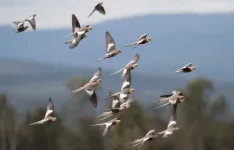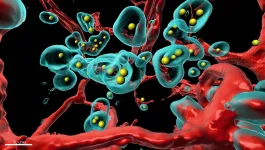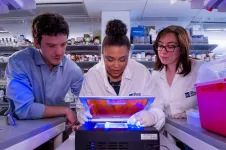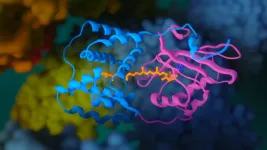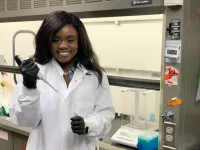(Press-News.org) There are roughly 50 billion individual birds in the world, a new big data study by UNSW Sydney suggests - about six birds for every human on the planet.
The study - which bases its findings on citizen science observations and detailed algorithms - estimates how many birds belong to 9700 different bird species, including flightless birds like emus and penguins.
It found many iconic Australian birds are numbered in the millions, like the Rainbow Lorikeet (19 million), Sulphur-crested Cockatoo (10 million) and Laughing Kookaburra (3.4 million). But other natives, like the rare Black-breasted Buttonquail, only have around 100 members left.
The findings are being published this week in the Proceedings of the National Academy of Sciences.
"Humans have spent a great deal of effort counting the members of our own species - all 7.8 billion of us," says Associate Professor Will Cornwell, an ecologist at UNSW Science and co-senior author of the study.
"This is the first comprehensive effort to count a suite of other species."
The research team reached their figures by pooling together almost a billion bird sightings logged on eBird, an online database of bird observations from citizen scientists. Using this data - and detailed case studies where available - they then developed an algorithm to estimate the actual global population of each bird species.
This calculation took into account each species' 'detectability' - that is, how likely it is that a person will have spotted this bird and submitted the sighting to eBird. Detectability can include factors like their size, colour, whether they fly in flocks, and if they live close to cities.
"While this study focuses on birds, our large-scale data integration approach could act as a blueprint for calculating species-specific abundances for other groups of animals," says study lead author Dr Corey Callaghan, who completed the research while he was a postdoctoral researcher at UNSW Science.
"Quantifying the abundance of a species is a crucial first step in conservation. By properly counting what's out there, we learn what species might be vulnerable and can track how these patterns change over time - in other words, we can better understand our baselines."
The study dataset includes records for almost all (92 per cent) bird species currently alive. However, the researchers say it's unlikely the remaining 8 per cent - which were excluded for being so rare that we lacked available data - would have much impact on the overall estimate.
Only four bird species belonged to what the researchers call 'the billion club': species with an estimated global population of over a billion. The House Sparrow (1.6 billion) heads this exclusive group, which also includes the European Starling (1.3 billion), Ring-billed Gull (1.2 billion) and Barn Swallow (1.1 billion).
"It was surprising that only a few species dominate the total number of individual birds in the world," says Dr Callaghan, who is now based at the German Centre for Integrative Biodiversity Research (iDiv) Halle-Jena-Leipzig.
"What is it about those species, evolutionarily, that has made them so hyper-successful?"
But while some bird populations are thriving, many others look a lot slimmer: around 12 per cent of bird species included in the study have an estimated global population of less than 5000. These include species such as the Chinese Crested Tern, Noisy Scrub-bird, and Invisible Rail.
"We'll be able to tell how these species are faring by repeating the study in five or 10 years," says A/Prof. Cornwell.
"If their population numbers are going down, it could be a real alarm bell for the health of our ecosystem."
A global effort
The study was made possible with the help of more than 600,000 citizen scientists who contributed their sightings to the eBird dataset between 2010 and 2019.
The Cornell Lab of Ornithology, who run the eBird site, have made the data freely available.
"Large global citizen science databases such as eBird are revolutionising our ability to study macroecology," says A/Prof. Cornwell.
"This type of data simply wasn't available a decade ago."
While the research team are confident in their estimates, they acknowledge a degree of uncertainty is inevitable when working with large datasets like this.
For example, people who document the sightings may be more likely to seek out rare species, or a species may be so rare that there simply isn't enough data.
"A range of uncertainty is necessary when making global-level estimates," says Professor Shinichi Nakagawa, an ecologist and statistician at UNSW Science and co-senior author of the paper.
"Our findings, while rough in some areas, represent the best-available data we currently have for many species."
New data is continuously added to eBird from both past records and present-day sightings. The research team plan to repeat their analysis as more data becomes available.
"We will need to repeat and refine this effort to really keep tabs on biodiversity - especially as human-caused changes to the world continue and intensify," says Dr Callaghan.
A timeless hobby
Birdwatching - or 'birding' for more serious enthusiasts - is a popular hobby that dates back to the late 18th century. The growing popularity of citizen scientist apps and websites have made birdwatching an accessible way to engage with science.
"Birding is a hobby that just keeps on giving," says Dr Callaghan.
"You can usually find a bird or two to identify and watch anywhere you go, anytime of the day, anywhere in the world."
People interested in being involved with the project can create a birdwatching account on eBird - and A/Prof. Cornwell says that you don't need to be a bird expert to get started.
"A great starting point is to learn a handful of birds that come to your local area, like Rainbow Lorikeets, Sulphur Crested Cockatoo, and Australian White Ibis," he says.
"It can be as simple as seeing if you can spot any out the window while you're drinking your coffee in the morning."
INFORMATION:
Scientists studying the impact of record heat and drought on intact African tropical rainforests were surprised by how resilient they were to the extreme conditions during the last major El Niño event.
The international study, reported in Proceedings of the National Academy of Sciences today, found that intact rainforests across tropical Africa continued to remove carbon from the atmosphere before and during the 2015-2016 El Niño, despite the extreme heat and drought.
Tracking trees in 100 different tropical rainforests across six African countries, the researchers found that intact forests across the continent still removed 1.1 billion tonnes of carbon dioxide per year from the atmosphere during the El Niño monitoring ...
Researchers at Baylor College of Medicine have followed the progression of breast cancer in an animal model and discovered a path that transforms a slow-growing type of cancer known as estrogen receptor (ER)+/HER2+ into a fast-growing ER-/HER2+ type that aggressively spreads or metastasizes to other organs.
The study, which appears in the Proceedings of the National Academy of Sciences, has implications for breast cancer therapy as it suggests the need to differentiate cancer subtypes according to the path the cells follow. Different paths might be linked to different cancer behavior, which should be taken into consideration to plan treatment appropriately.
"In ...
Scientists have detected new early-warning signals indicating that the central-western part of the Greenland Ice Sheet may undergo a critical transition relatively soon. Because of rising temperatures, a new study by researchers from Germany and Norway shows, the destabilization of the ice sheet has begun and the process of melting may escalate already at limited warming levels. A tipping of the ice sheet would substantially increase long-term global sea level rise.
"We have found evidence that the central-western part of the Greenland ice sheet has been destabilizing and is now close to a critical transition," explains lead author Niklas ...
A new technology developed by UZH researchers enables the body to produce therapeutic agents on demand at the exact location where they are needed. The innovation could reduce the side effects of cancer therapy and may hold the solution to better delivery of Covid-related therapies directly to the lungs.
Scientists at the University of Zurich have modified a common respiratory virus, called adenovirus, to act like a Trojan horse to deliver genes for cancer therapeutics directly into tumor cells. Unlike chemotherapy or radiotherapy, this approach does no harm to normal healthy cells. Once inside tumor cells, the delivered genes serve as a blueprint for therapeutic ...
When doctors or scientists want to peer into living tissue, there's always a trade-off between how deep they can probe and how clear a picture they can get.
With light microscopes, researchers can see submicron-resolution structures inside cells or tissue, but only as deep as the millimeter or so that light can penetrate without scattering. Magnetic resonance imaging (MRI) uses radio frequencies that can reach everywhere in the body, but the technique provides low resolution -- about a millimeter, or 1,000 times worse than light.
A University of California, Berkeley, researcher has now shown that microscopic ...
PHILADELPHIA and MELBOURNE, Australia -- (May. 17, 2021) -- A team of scientists from The Wistar Institute in Philadelphia and the Peter MacCallum Cancer Center in Melbourne, Australia, discovered a new checkpoint mechanism that fine-tunes gene transcription. As reported in a study published in Cell, a component of the Integrator protein complex tethers the protein phosphatase 2A (PP2A) to the site of transcription allowing it to stop the activity of the RNA polymerase II enzyme (RNAPII). Disruption of this mechanism leads to unrestricted gene transcription and is implicated in cancer.
The study points to new viable opportunities for therapeutic ...
Exposure to light is compulsory for photosynthetic organisms for the conversion of inorganic compounds into organic ones. However, if there is too much solar energy, the photosystems and other cell components could be damaged. Thanks to special protective proteins, the overexcitation is converted into heat - in the process called non-photochemical quenching. The object of the published study, OCP, was one of such defenders. It was first isolated in 1981 from representatives of the ancient group of photosynthetic bacteria, ?yanobacteria. OCP comprises two domains forming a cavity, in which a carotenoid pigment is embedded.
"When light is absorbed by the carotenoid molecule, OCP can change from an inactive orange to an active red form. ...
For much of the nation's food supply, removing unsafe products off of store shelves can take up to 10 months, according to news reports -- even when people are getting sick.
The growing complexity and scope of modern supply chains result in painfully slow product recalls, even when consumer well-being is at stake. For example, in 2009, salmonella-tainted peanuts killed nine people and sickened more than 700 in 46 states, and the resulting nationwide recall cost peanut farmers, their wholesale customers and retailers more than $1 billion in lost production ...
Viruses attack the body by sending their genetic code -- DNA and RNA -- into cells and multiplying. A promising class of therapeutics that uses synthetic nucleic acids to target and shut down specific, harmful genes and prevent viruses from spreading is gaining steam.
However, only a handful of siRNA, or other RNA interference-based therapeutics have been approved. One of the main problems is getting the siRNA into the body and guiding it to the target.
Chemical engineering researchers in the Cockrell School of Engineering aim to solve that problem, while improving the targeting effectiveness of siRNA. In a new paper in the Journal of Controlled Release, the researchers created several different types of nanoparticles and analyzed them for the ability to deliver and protect siRNA from ...
May 17, 2021 - Amid the rising toll of opioid overdoses and deaths in the U.S., several states are considering laws enabling civil commitment for involuntary treatment of patients with substance use disorders (SUDs). Most addiction medicine physicians support civil commitment for SUD treatment - but others strongly oppose this approach, reports a survey study in Journal of Addiction Medicine, the official journal of the American Society of Addiction Medicine (ASAM). The journal is published in the Lippincott portfolio by Wolters Kluwer.
"Civil commitment has emerged as a sometimes compelling yet controversial policy option," according to the new study, led by Abhishek Jain, MD. At the time of ...
